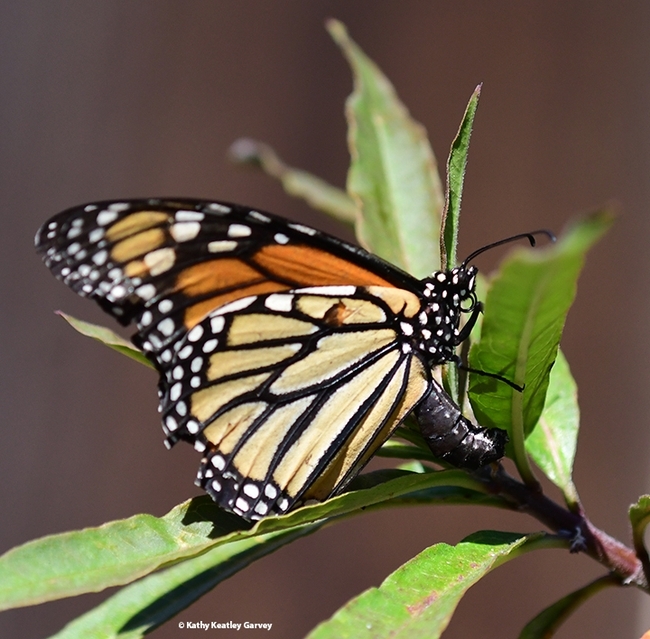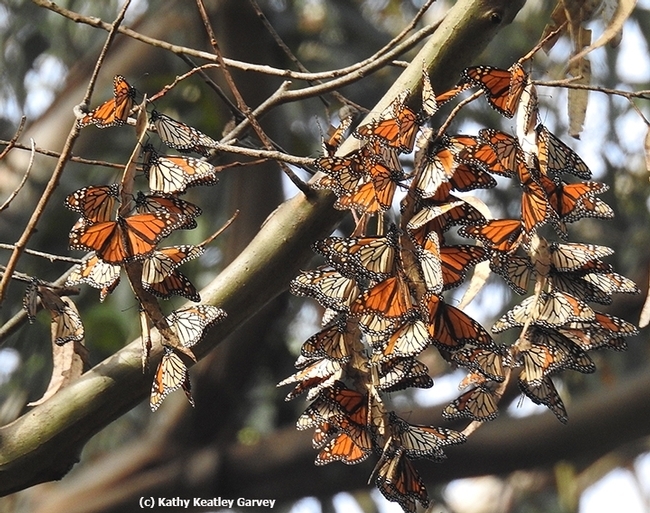Jan 25, 2022
How little we know about monarch butterflies, Danaus plexippus... A monarch butterfly ovipositing. (Photo by Kathy Keatley Garvey)
A monarch butterfly ovipositing. (Photo by Kathy Keatley Garvey)
And how long misinformation can linger...
Take the news about the overwintering 250,000 monarchs recorded along the California coast in the Western Monarch Thanksgiving Count spearheaded by the Xerces Society for Invertebrate Conservation. That's more than a 100-fold increase from the previous year.
Everyone wants to know why.
Butterfly guru Art Shapiro, a UC Davis distinguished professor of evolution and ecology who has been monitoring butterfly populations in Central California since 1972--and maintains a research website at https://butterfly.ucdavis.edu--wants to know where they came from. He acknowledges he does not know, nor does anyone else. Yet.
Butterfly guru Art Shapiro, a UC Davis distinguished professor of evolution and ecology who has been monitoring butterfly populations in Central California since 1972--and maintains a research website at https://butterfly.ucdavis.edu--wants to know where they came from. He acknowledges he does not know, nor does anyone else. Yet.
"To paraphrase Socrates, to understand what one does not understand is the beginning of wisdom," Shapiro says.
Lynn Kimsey, director of the Bohart Museum of Entomology and a UC Davis distinguished professor of entomology, says we shouldn't consider the population increase a trend, that it's still too early to figure out what's going on.
Says Bohart associate Greg Kareofelas: "I think it is hopeful, but we will not know for sure until 5 or 10 years have gone by. One year is not a trend."
Lynn Kimsey, director of the Bohart Museum of Entomology and a UC Davis distinguished professor of entomology, says we shouldn't consider the population increase a trend, that it's still too early to figure out what's going on.
Says Bohart associate Greg Kareofelas: "I think it is hopeful, but we will not know for sure until 5 or 10 years have gone by. One year is not a trend."

UC Davis Professor Louie Yang
Professor and monarch scientist Elizabeth Crone of Tufts University who recently completed a six-month sabbatical at UC Davis, says: "I think there are two striking things about this year's uptick in monarchs:"
- "It is great to have more breathing room, but we're not out of the woods yet, in terms of conservation. The current population is still < 5% of our estimates from the 1980's and has only been that large for one year."
- "When populations reach unprecedented sets of conditions (in this case, lower overwintering numbers than we had ever seen before, from 2018-2020), we should expect the unexpected. And one thing to emphasize is"
- "We expect large fluctuations in abundance of butterflies and many other insect species. We need to manage for resilience, because we probably won't be able to understand every crash or rebound." (See her UC Davis seminar)

Hugh Dingle, UC Davis emeritus professor
But a key point is this: "There are NOT two populations of the monarch in North America," says migration expert and monarch scientist Hugh Dingle, emeritus professor, UC Davis Department of Entomology and Nematology. "The population is all one and the butterflies from all over North America mix in Mexico during the winter diapause. The monarchs breeding in the west (of the Rockies) have at least two (and probably three) migration routes in the fall--one is to the California coast, one is down the Colorado River Valley into Mexico, and the probable third is east of the Great Salt Lake and west of the Wasatch down through eastern Arizona and into Mexico. Sample sizes are small for the third route which is why it is only probable. Also genetic data going back 50 years shows that the North American population is all one, that is, work by Walter Eanes and others including recent molecular genetics studies!"
The western migration routes are outlined in Dingle et al. Biological Journal of the Linnaean Society 85:491-500 (2005), and for various evolutionary changes in monarch migration and correlated characters see Freedman, Dingle, et al. B. J. Linn. Soc. 123:265-278 (2018), Animal Migration 5:61-73 (2018), and the Proceedings of the National Academy of Sciences (PNAS) 117: 28887-28893(2020) and references therein.
Commented Dingle: "The old saw about two North American populations is a good example of once something gets into the literature--or into the public domain-- it becomes exceedingly difficult to correct."
Now scientists are trying to figure out what contributed to the increase in the population. And where they came from.
Remember back in 2019 when Shapiro declared that the monarch population is on life support?
Hold on...
Topics:
Attached Images:
